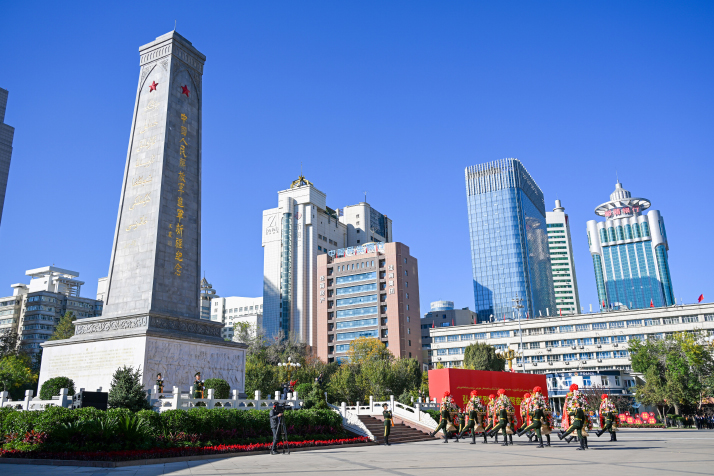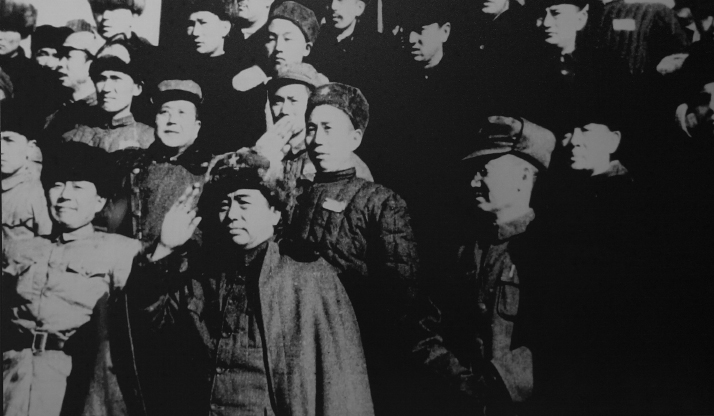| Xinjiang Today |
| Peaceful liberation: a historic choice | |
|
|
 A ceremony commemorating Xinjiang's peaceful liberation takes place at the People's Square in Urumqi on September 30, 2024 (XINHUA)
On the south side of the People's Square in downtown Urumqi stands a grayish-white monument. Inscribed on its north face are the words "In Memory of the People's Liberation Army (PLA)'s March Into Xinjiang" in the handwriting of General Wang Zhen. Wang played a key role in Xinjiang's liberation and development shortly before and after the founding of the People's Republic of China on October 1, 1949. The reliefs on the monument's base depict scenes of Xinjiang's liberation, land reclamation, border defense and ethnic unity. The inscriptions on the base are engraved in both standard Chinese and Uygur. In just over 500 characters, they recount how Xinjiang threw off the shackles of the Kuomintang (KMT) regime along with the rest of the country. Turning to a Xinjiang Daily newspaper edition published on September 28, 1949, we find a front-page editorial titled Celebrating the Peaceful Liberation of Xinjiang alongside the report The Entire Region Joins the Camp for People's Democracy—Garrison Troops in Xinjiang Announce Uprising. These documents also capture the historic moment 76 years ago. Xinjiang in 1949 In 1949, the Communist Party of China (CPC) won a victory in the War of Liberation against the KMT regime. Following the strategic deployment of the CPC Central Committee and Chairman Mao Zedong, the PLA First Field Army issued an order on August 31, 1949, to advance into the Hexi Corridor. The Hexi Corridor, located in neighboring Gansu Province, runs east to west, connecting Xinjiang with other parts of China. According to the order, on September 21, the First Field Army reached Wuwei, Jiuquan and Anxi, towns at the western end of the Hexi Corridor, approaching Xinjiang. At this time, Xinjiang was not only a crucial stronghold for the KMT forces that had not fled to Taiwan but also a target for hostile external forces aiming to split Xinjiang from China. Tao Zhiyue, Commander in Chief of the Xinjiang Garrison, was a key KMT figure in Xinjiang. In his memoirs, Tao later stated that he fully understood that continued resistance against the PLA would only lead to more casualties and destruction. Therefore, Tao decided to stage an uprising against the KMT regime. However, three senior officers under Tao vehemently opposed the uprising. These three not only commanded significant military power but also maintained close ties with the KMT high command. Furthermore, U.S. diplomats stationed in Xinjiang including John Hall Paxton were organizing "East Turkestan" activities. Simultaneously, they were instigating warlords such as Ma Bufang of Qinghai and Ma Hongkui of Ningxia to retreat to Xinjiang and collude with Xinjiang's reactionary forces to establish an "Islamic Republic" and secede from China.  A rally welcoming the People's Liberation Army is held in Urumqi in November 1949 (VCG)
Peaceful uprising Amid the political turbulence in Xinjiang, a secret envoy arrived in Urumqi, then known as Dihua, on September 15, 1949. He was Deng Liqun, a liaison officer of the CPC Central Committee, who stayed at the residence of Burhan Shahidi, Chairman of the then KMT Xinjiang Provincial Government. On September 16, Deng met with Tao and Burhan. Both expressed their gratitude for the trust placed in them by the CPC and voiced their determination to follow the Party's guidance and the people's will toward a peaceful uprising. Though Tao faced strong opposition from his three subordinates, he did not choose to suppress them by force. Instead, he sought a peaceful resolution through negotiation and compromise. Tao held several talks with them, explaining the futility of continued resistance. Eventually, the three agreed to surrender their military command on the condition they be allowed to leave with their personal belongings and assets. On September 23, 1949, Tao arranged for them to depart Xinjiang. Two days later, the KMT troops stationed in Xinjiang, led by Tao, officially announced their uprising, achieving Xinjiang's peaceful liberation. This decision averted a large-scale war, protected the lives and property of all ethnic groups in Xinjiang, and laid the foundation for Xinjiang's stable development. On October 12, the PLA departed from Gansu and advanced westward into Xinjiang. Peng Dehuai, Commander in Chief of the First Field Army, convened a meeting to arrange the military deployment. In line with the CPC Central Committee and Chairman Mao's instructions, Peng issued several key policy directives: respecting minority customs; helping all ethnicities build a happy life; welcoming former KMT troops to join the PLA; remaining vigilant against sabotage by imperialist and reactionary forces; and strengthening Sino-Soviet friendship. On December 17, 1949, the Central People's Government approved the formation of the Xinjiang Provincial People's Government with Burhan as chairman. On the same day, the Xinjiang Military Command was also established with Peng as commander and political commissar, and Wang, Tao and Saifuddin Azizi as deputy commanders. From that moment, the people of all ethnic groups in Xinjiang were politically liberated and became masters of their own destiny. Xinjiang remained a province until 1955 when Xinjiang Uygur Autonomous Region was established. Historical importance The peaceful liberation of Xinjiang enabled the region to end the rule of the KMT regime without the use of military force and thwarted attempts by foreign powers to incite separatism. It ensured the stability and integrity of China's vast territory and strengthened the country's sovereignty and unity. People of all ethnic backgrounds in Xinjiang were able to live in peace, and ethnic interaction, communication and integration continued to deepen. This historical event was a victory for the CPC in the borderlands of northwest China. It ensured long-term peace and stability in this strategic region. The peaceful liberation meant the end of oppression for all ethnic groups. The new government's policy of treating all ethnicities equally eliminated the roots of ethnic discrimination. Different groups began to coexist in harmony, respecting and supporting one another in the process of pursuing shared development, thereby laying a solid foundation for harmonious and stable ethnic relations. It also strengthened the sense of belonging and pride among all as members of the larger Chinese nation, enhancing national cohesion and unity. After the liberation, the Central Government decided to demobilize some PLA units, forming the Xinjiang Production and Construction Corps (XPCC). Overcoming numerous hardships, the XPCC played a major role in stabilizing and developing Xinjiang. Generations of XPCC members have carried forward the spirit of hard work and selfless dedication, continuing to write new chapters in the construction of a beautiful Xinjiang. Today, the XPCC administers an area of some 70,000 square km with a population of more than 3 million. After Xinjiang's peaceful liberation, the government was able to strengthen military deployment and border control, effectively resisting foreign infiltration and safeguarding frontier security. This not only ensured stability in the northwest but also served as a vital shield for national security. It created a secure environment for friendly exchanges with neighboring countries and peaceful cooperation in border areas. Comments to lanxinzhen@cicgamericas.com |
|
||||||||||||||||||||||||||||
|